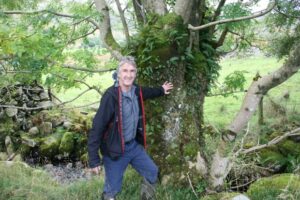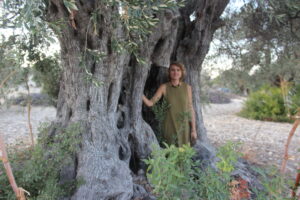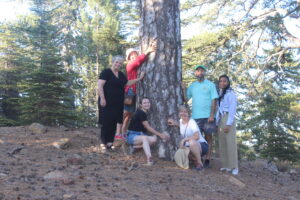Cyprus Mail 12 January 2022 - by Martin Clark, guest columnist
The beautiful island of Cyprus has some wonderful examples, from the coastal plains, right up to the top of the Troodos mountains. Unfortunately, for the first time in multiple generations of humankind, they’re in great danger!
Here in Cyprus with ancient olive trees, their regular pruning, keeps them vigorous! If the weight of the upper branches does not become too great, the trunk gets fatter and fatter and more resilient to the passage of time. Even if the centre rots and hollows out, the structural strength is not much reduced; in fact, we could say the tree is recycling its own deadwood. Eventually, a very old tree will divide into 4 to 8 separate trees. The same process happens with old carob trees. The situation regarding a lack of rural labour is so bad all over Cyprus, and olives are not picked and the pruning is not done. If this continues, the weight of the trees’ crowns become so great that the top-heavy olive trees split open and fall to the ground. So, these ancient trees’ longevity depends on man’s intervention.

A parallel in the United Kingdom would be ancient ash trees in the Lake District that had the leaves and upper branches cut regularly to feed sheep and cattle with leaf hay; the ash trees likewise became very old and fat (about a thousand years old). Also in Windsor Great Park, oaks had upper branches cut for building ships. In all these cases the management process is called ‘pollarding’ and it was done on a cycle of 1 to 20 years.
Around Lefkara, the high pruning/pollarding is just not getting done. To maintain the health of the ancient olive trees, the Forestry Department in Kornos and Lythrodondas stepped in. There are several examples of 1,000-year old plus olive trees in Cyprus; the ones I am most familiar with are between Kato Lefkara and the Diptomos dam. They were planted by the Byzantines, Crusaders and Franks. In 1192, Richard the Lionheart gifted Cyprus to the French Lusignans and this ushered in the ‘Frankish period’. As refugees from Aleppo in Syria after the collapse of the last crusade, the Lusignans were rather partial to eating olives and using olive oil, so there was a new rush to plant more olives, literally 830 years ago. These trees are known by Cypriot villagers as ‘Frangikes’ (Φράγκικες). They have been looked after and maintained for between 40 and 50 generations; only now, in the last 2 generations, have things started to go wrong.

A lack of will, labour and skills, is not the only problem facing ancient olives. Climate change in Cyprus means summers are hotter and drier; this year was a good example, so olives did not get enough water in many areas and the crop is very meagre. It’s necessary to have a minimum of 100 kilograms to even think of going to the olive mill to press them for oil, so many trees are not getting picked, no money, no maintenance. Wildfires have also meant an end to many truly ancient trees (carobs as well as olives). Most agree that the incidence of wildfires is increasing, July and August this year saw some very destructive fires in Arakapas, Ora and Odou.
As well as olive trees, the Troodos Forest Park, high in the mountainous interior of Cyprus has truly ancient trees. The oldest black pines (Pinus nigra) and junipers (Juniperus foetidissima ) are 3,000 and 2,000 years old respectively. A section through an ancient pine in the Forestry Department visitor centre has the tree growth ring, marking the birth of Jesus Christ, clearly marked. Another cross section of a trunk in the restaurant of the hotel has 2,700 identifiable annual growth rings. The rather barren and stony landscape right at the top of the Troodos mountains has many ancient conifers but a closer look reveals more crown dieback, reduced foliage and increased insect attack. All this is the result of climate change, hotter and drier and with extended growing seasons that exhaust the ancient trees and allow vigorous younger species to invade their space.

There are several ancient deciduous trees in close proximity to old buildings that are important and unique. At Kolossi castle close to Limassol, there is a wonderful rosewood tree (Tipuana tipu). Described as being about 200-300 years old, it looks much older but cannot be because it originates in Bolivia, where the conquistadors found it in 1528. The lower branches are all supported by props and a great variety of lizards inhabit the massive trunk. Another favourite ancient tree for me is the Mount Atlas mastic tree (Pistacia atlantica), known in Cyprus as ‘Tremithos’. The Paphos chewing gum is produced from ‘Trementina’, the resin of this tree. The Department of Forests has tried to protect and guard the species by declaring them Monuments of Nature. The largest Tremithos is located in Polis Chrysochous and is estimated to be around 1,500 years old. Other protected Tremithos trees are located in the villages of Simos, Kritos Marottos and Limnati, while some protected clusters of trees are located in the villages of Emba and Tala. In Kiti, at the ancient church of Panagia Angeloktisti, one of the oldest churches in Cyprus and built on the ruins of a 5th century early Christian basilica, there is a fantastic mastic tree that could be almost as old as the church.
Maybe the biggest problem facing all ancient trees, is that not enough people recognise the value of them. Here’s the reasons why we should value them at least as much as ancient buildings:
- They are ancient living plants and a testament to the endeavours of our shared European ancestors.
- The older a tree gets, the more ecological niches it has – places where different species thrive; from lichens and mosses to mites, spiders and insects, to reptiles, mammals and birds. A 1,000-year-old olive might have 300 other species depending on it. This is important for biodiversity.
- The ancient trees are a critical part of our cultural landscape, when they are lost, that landscape changes forever and cannot be reproduced. They are examples of living history.
- They are a marker that helps us to date close-by buildings, thereby increasing our understanding of history and the slow passage of time. A 700-year-old olive within the footprint of a building means that building is at least that age.
- Ancient trees are a living seed bank, providing seeds and cuttings for new trees. The healthiest natural ecosystems have trees of all ages plus a minimum 11 per cent of deadwood to support insects, fungi, hole nesting birds.
So, what to do? I propose that with European Union help, we begin in Cyprus an international training programme on the topic of managing ancient trees and train a cohort of younger people to do this type of management and maintenance work. You see, there are people of all ages who really do care about ancient trees, and some of them have the energy, they just need the skills and the mandate to do it.
Thanks to Cyprus Center for Environmental Research and Education (CYCERE)
Martin Clark (a professional forester and land manager) is director of Grampus Heritage & Training, the UK’s most successful EU wide vocational training organisation, with 26 years’ experience
